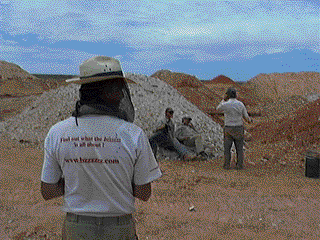As soon as the wind picks up, the dust blows into every pore of your body, and when it only gusts, the flies come out of the ether to absorb any moisture like from your perspiration, and even from your breath. These flies are absorbing the water vapor coming from Milton’s shoulders.

It can cause a 5 minute delay of operations if the checker or the machine operator ‘inhales’ a single fly…:-)

You can consume as much as $130 per day in fuel, and you may go for days without finding anything, and often decide to give up the claim and find another place to dig. And another creditor or partner !
Given the base line costs of the machine, and the investment, and the labor, there is the problem with physical discomfort and disappointment.
With no wind, you get flies, and dust kicked up by the excavator, but if the wind is up, the dust is choking and unavoidable, and the flies are fewer and you sometimes drop your guard!
Here is what it looks like to be at the face of the mine, looking up at the excavator and the pounding sun…

Kent has had 5 seasons of operating the machine now and is quite competent and even sometimes ‘playful’, best of all, he doesn’t dump dirt on you….!
So what’s this all about, and why do those few miners scattered across so many thousands of square miles of opal fields are forever driven to ‘move the dirt’ once bitten ?

